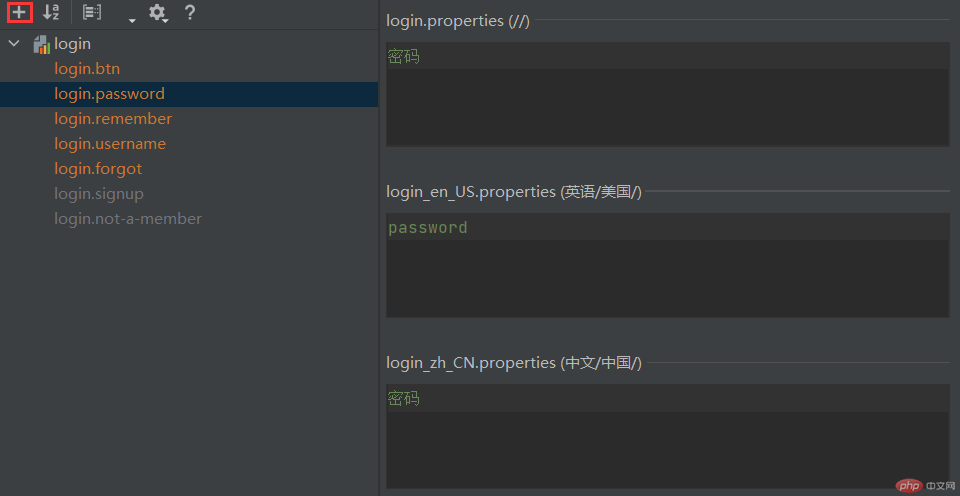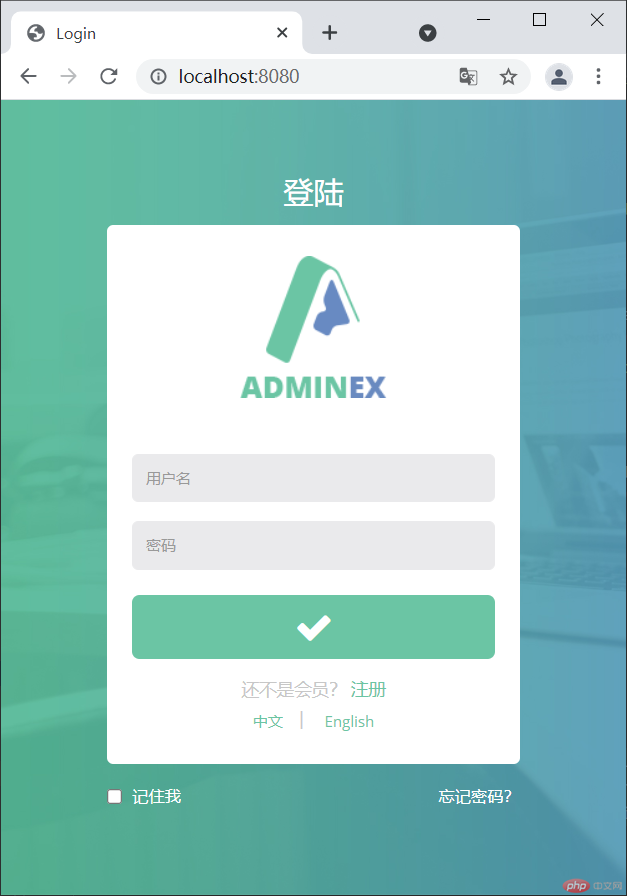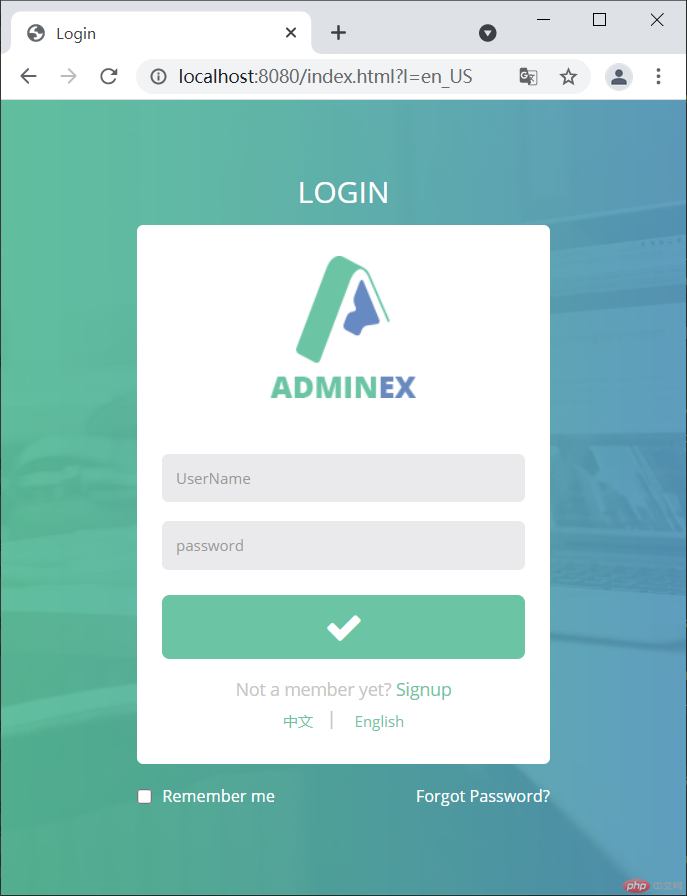国际化(Internationalization 简称 I18n,其中“I”和“n”分别为首末字符,18 则为中间的字符数)是指软件开发时应该具备支持多种语言和地区的功能。
换句话说就是,开发的软件需要能同时应对不同国家和地区的用户访问,并根据用户地区和语言习惯,提供相应的、符合用具阅读习惯的页面和数据,例如,为中国用户提供汉语界面显示,为国外用户提供提供英语界面显示。
在 Spring 项目中实现国际化,通常需要以下 3 步:
在 Spring Boot 的类路径下创建国际化资源文件,文件名格式为:基本名语言代码国家或地区代码,例如 login_en_US.properties、login_zh_CN.properties。
以 spring-boot-springmvc-demo1为例,在 src/main/resources 下创建一个 i18n 的目录,并在该目录中按照国际化资源文件命名格式分别创建以下三个文件,
以上国际化资源文件创建完成后,IDEA 会自动识别它们,并转换成如下的模式:
图1:国际化资源文件
打开任意一个国际化资源文件,并切换为 Resource Bundle 模式,然后点击“+”号,创建所需的国际化属性,如下图。
图2:编辑国际化资源文件
Spring Boot 已经对 ResourceBundleMessageSource 提供了默认的自动配置。
Spring Boot 通过 MessageSourceAutoConfiguration 对 ResourceBundleMessageSource 提供了默认配置,其部分源码如下。
@Configuration(proxyBeanMethods = false)@ConditionalOnMissingBean(name = AbstractApplicationContext.MESSAGE_SOURCE_BEAN_NAME, search = SearchStrategy.CURRENT)@AutoConfigureOrder(Ordered.HIGHEST_PRECEDENCE)@Conditional(org.springframework.boot.autoconfigure.context.MessageSourceAutoConfiguration.ResourceBundleCondition.class)@EnableConfigurationPropertiespublic class MessageSourceAutoConfiguration {private static final Resource[] NO_RESOURCES = {};// 将 MessageSourceProperties 以组件的形式添加到容器中// MessageSourceProperties 下的每个属性都与以 spring.messages 开头的属性对应@Bean@ConfigurationProperties(prefix = "spring.messages")public MessageSourceProperties messageSourceProperties() {return new MessageSourceProperties();}//Spring Boot 会从容器中获取 MessageSourceProperties// 读取国际化资源文件的 basename(基本名)、encoding(编码)等信息// 并封装到 ResourceBundleMessageSource 中@Beanpublic MessageSource messageSource(MessageSourceProperties properties) {ResourceBundleMessageSource messageSource = new ResourceBundleMessageSource();//读取国际化资源文件的 basename (基本名),并封装到 ResourceBundleMessageSource 中if (StringUtils.hasText(properties.getBasename())) {messageSource.setBasenames(StringUtils.commaDelimitedListToStringArray(StringUtils.trimAllWhitespace(properties.getBasename())));}//读取国际化资源文件的 encoding (编码),并封装到 ResourceBundleMessageSource 中if (properties.getEncoding() != null) {messageSource.setDefaultEncoding(properties.getEncoding().name());}messageSource.setFallbackToSystemLocale(properties.isFallbackToSystemLocale());Duration cacheDuration = properties.getCacheDuration();if (cacheDuration != null) {messageSource.setCacheMillis(cacheDuration.toMillis());}messageSource.setAlwaysUseMessageFormat(properties.isAlwaysUseMessageFormat());messageSource.setUseCodeAsDefaultMessage(properties.isUseCodeAsDefaultMessage());return messageSource;}...}
从以上源码可知:
查看 MessageSourceProperties 类,其代码如下。
public class MessageSourceProperties {private String basename = "messages";private Charset encoding;@DurationUnit(ChronoUnit.SECONDS)private Duration cacheDuration;private boolean fallbackToSystemLocale;private boolean alwaysUseMessageFormat;private boolean useCodeAsDefaultMessage;public MessageSourceProperties() {this.encoding = StandardCharsets.UTF_8;this.fallbackToSystemLocale = true;this.alwaysUseMessageFormat = false;this.useCodeAsDefaultMessage = false;}...}
通过以上代码,我们可以得到以下 3 点信息:
通过以上源码分析可知,Spring Boot 已经对国际化资源文件的管理提供了默认自动配置,我们这里只需要在 Spring Boot 全局配置文件中,使用配置参数“spring.messages.basename”指定我们自定义的国际资源文件的基本名即可,代码如下(当指定多个资源文件时,用逗号分隔)。
spring.messages.basename=i18n.login
由于页面使用的是 Tymeleaf 模板引擎,因此我们可以通过表达式 #{…} 获取国际化内容。
以 spring-boot-adminex 为例,在 login.html 中获取国际化内容,代码如下。
<!DOCTYPE html><html lang="en" xmlns:th="http://www.thymeleaf.org"><head><meta charset="utf-8"><meta name="viewport" content="width=device-width, initial-scale=1.0, maximum-scale=1.0"><meta name="description" content=""><meta name="author" content="ThemeBucket"><link rel="shortcut icon" href="#" type="image/png"><title>Login</title><!--将js css 等静态资源的引用修改为 绝对路径--><link href="css/style.css" th:href="@{/css/style.css}" rel="stylesheet"><link href="css/style-responsive.css" th:href="@{/css/style-responsive.css}" rel="stylesheet"><!-- HTML5 shim and Respond.js IE8 support of HTML5 elements and media queries --><!--[if lt IE 9]><script src="js/html5shiv.js" th:src="@{/js/html5shiv.js}"></script><script src="js/respond.min.js" th:src="@{/js/respond.min.js}"></script><![endif]--></head><body class="login-body"><div class="container"><form class="form-signin" th:action="@{/user/login}" method="post"><div class="form-signin-heading text-center"><h1 class="sign-title" th:text="#{login.btn}">Sign In</h1><img src="/images/login-logo.png" th:src="@{/images/login-logo.png}" alt=""/></div><div class="login-wrap"><p style="color: red" th:text="${msg}" th:if="${not #strings.isEmpty(msg)}"></p><input type="text" class="form-control" name="username" placeholder="User ID" autofocusth:placeholder="#{login.username}"/><input type="password" class="form-control" name="password" placeholder="Password"th:placeholder="#{login.password}"/><label class="checkbox"><input type="checkbox" value="remember-me" th:text="#{login.remember}"><span class="pull-right"><a data-toggle="modal" href="#myModal" th:text="#{login.forgot}"> </a></span></label><button class="btn btn-lg btn-login btn-block" type="submit"><i class="fa fa-check"></i></button><div class="registration"><!--Thymeleaf 行内写法-->[[#{login.not-a-member}]]<a class="" href="/registration.html" th:href="@{/registration.html}">[[#{login.signup}]]</a><!--thymeleaf 模板引擎的参数用()代替 ?--><br/><a class="btn btn-sm" th:href="@{/index.html(l='zh_CN')}">中文</a>|<a class="btn btn-sm" th:href="@{/index.html(l='en_US')}">English</a></div></div><!-- Modal --><div aria-hidden="true" aria-labelledby="myModalLabel" role="dialog" tabindex="-1" id="myModal"class="modal fade"><div class="modal-dialog"><div class="modal-content"><div class="modal-header"><button type="button" class="close" data-dismiss="modal" aria-hidden="true">×</button><h4 class="modal-title">Forgot Password ?</h4></div><div class="modal-body"><p>Enter your e-mail address below to reset your password.</p><input type="text" name="email" placeholder="Email" autocomplete="off"class="form-control placeholder-no-fix"></div><div class="modal-footer"><button data-dismiss="modal" class="btn btn-default" type="button">Cancel</button><button class="btn btn-primary" type="button">Submit</button></div></div></div></div><!-- modal --></form></div><!-- Placed js at the end of the document so the pages load faster --><!-- Placed js at the end of the document so the pages load faster --><script src="js/jquery-1.10.2.min.js" th:src="@{/js/jquery-1.10.2.min.js}"></script><script src="js/bootstrap.min.js" th:src="@{/js/bootstrap.min.js}"></script><script src="js/modernizr.min.js" th:src="@{/js/modernizr.min.js}"></script></body></html>
启动 Spring Boot,使用浏览器访问登陆页,此时浏览器默认使用中文,结果如下图。
图3:中文登陆页
将浏览器语言切换为英文,再次访问登陆页,结果如下图。
图4:英文登录页(猛击图片,查看原图)
如下图所示,在登陆页(login.html)最下方有两个切换语言的链接,想要通过点击它们来切换进行国际化的语言,该怎么做呢?
图5:切换语言按钮
我们知道,Spring MVC 进行国际化时有 2 个十分重要的对象:
我们可以通过以上两个对象对区域信息的切换,以达到切换语言的目的。
Spring Boot 在 WebMvcAutoConfiguration 中为区域信息解析器(LocaleResolver)进行了自动配置,源码如下。
@Bean@ConditionalOnMissingBean(name = DispatcherServlet.LOCALE_RESOLVER_BEAN_NAME)@SuppressWarnings("deprecation")public LocaleResolver localeResolver() {if (this.webProperties.getLocaleResolver() == WebProperties.LocaleResolver.FIXED) {return new FixedLocaleResolver(this.webProperties.getLocale());}if (this.mvcProperties.getLocaleResolver() == WebMvcProperties.LocaleResolver.FIXED) {return new FixedLocaleResolver(this.mvcProperties.getLocale());}AcceptHeaderLocaleResolver localeResolver = new AcceptHeaderLocaleResolver();Locale locale = (this.webProperties.getLocale() != null) ? this.webProperties.getLocale(): this.mvcProperties.getLocale();localeResolver.setDefaultLocale(locale);return localeResolver;}
从以上源码可知:
修改 login.html 切换语言链接,在请求中携带国际化区域信息,代码如下。
<!--thymeleaf 模板引擎的参数用()代替 ?--><a class="btn btn-sm" th:href="@{/index.html(l='zh_CN')}">中文</a>|<a class="btn btn-sm" th:href="@{/index.html(l='en_US')}">English</a>
在 net.biancheng.www 下创建一个 component 包,并在该包中创建一个区域信息解析器 MyLocalResolver,代码如下。
package net.biancheng.www.componet;import org.springframework.util.StringUtils;import org.springframework.web.servlet.LocaleResolver;import javax.servlet.http.HttpServletRequest;import javax.servlet.http.HttpServletResponse;import java.util.Locale;//自定义区域信息解析器public class MyLocalResolver implements LocaleResolver {@Overridepublic Locale resolveLocale(HttpServletRequest request) {//获取请求中参数String l = request.getParameter("l");//获取默认的区域信息解析器Locale locale = Locale.getDefault();//根据请求中的参数重新构造区域信息对象if (StringUtils.hasText(l)) {String[] s = l.split("_");locale = new Locale(s[0], s[1]);}return locale;}@Overridepublic void setLocale(HttpServletRequest request, HttpServletResponse response, Locale locale) {}}
//将自定义的区域信息解析器以组件的形式添加到容器中@Beanpublic LocaleResolver localeResolver(){return new MyLocalResolver();}
启动 Spring Boot,访问登录页 login.html,结果如下图。
图6:默认登陆页
点击页面最下方的“English”链接,将语言切换到英语,结果如下图。
图7:切换国家化语言为英语
点击页面最下方的“中文”链接,将语言切换到中文,结果如下图。
图8:切换语言为中文

Copyright 2014-2025 https://www.php.cn/ All Rights Reserved | php.cn | 湘ICP备2023035733号